![]()
![]()
![]()
Use LEFT and RIGHT arrow keys to navigate between flashcards;
Use UP and DOWN arrow keys to flip the card;
H to show hint;
A reads text to speech;
37 Cards in this Set
- Front
- Back
|
if an osteochondroma becomes malignant what component develops malignancy
|
cartilagenous component
|
|
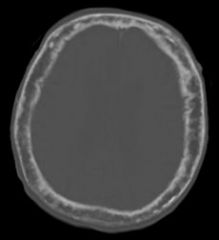
what
|
paget's dz of bone, usu localized to one or few bones; thickened irregular bone
|
|
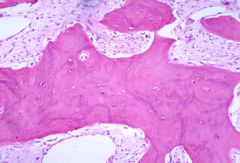
what
|
paget's dz of bone - thickened, irregular bone, can see increase in osteoclastic and later osteoblastic activity. can see increased blood alk phosphatase activity from the increase osteoblastic activity
|
|
|
is Multiple myeloma lytic, blastic or both
|
lytic
|
|
|
name some genetic associations with osteosarcoma
|
Paget's disease, fibrous dysplasia, enchondromatosis, and hereditary multiple exostoses
Li–Fraumeni syndrome |
|
|
where in the bone are osteosarcomas found
|
metaphysis
|
|
|
name three epiphyseal bone lesions
|
GCT (if growth plate is not closed), clear cell chondrosarcoma and chondroblastoma
|
|
|
where is fibrous dyplasia found
|
diaphyseal
|
|
|
where are adamantinomas found in bone
|
diaphyseal
|
|
|
where are osteoid osteomas found in bone
|
diaphyseal
|
|
|
where are chondromyxoid fibromas found in bone
|
diaphyseal
|
|
|
besides round cell tumors, what else are usu found in the diaphyseal region of bone
|
- adamantinoma
- osteoid osteoma - chondromyxoid fibroma - fibrous dysplasia - fibrosarcoma |
|
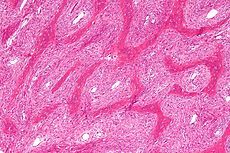
what
|
fibrous dysplasia - chinese letters (thin irregular), fibrotic marrow
|
|
|
name two syndromic situations in which one can encounter fibrous dyplasia of bone
|
McCune-Albright - severe polyostotic fibrous dysplasia, endocrine abnormalities, skin pigmentation
NFII - MISME syndrome (multiple inherited schwannomas (acoustic neuroma), meningiomas and ependymomas (czome 22, merlin gene) |
|
|
two most common locations for a chordoma
|
clivus and sacrum
|
|

what
|
chordoma, note midline
|
|
|
genetic association for chordoma
|
tuberous sclerosis
|
|
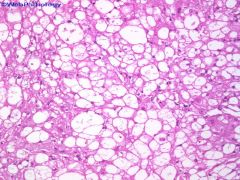
what
|
chordoma -
|
|
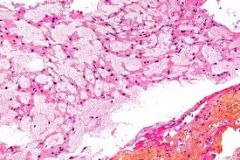
what
|
chordoma
|
|
|
chemical associations with angiosarcoma
|
(PVC) polymerization plants, arsenic-containing insecticides and Thorotrast.
|
|
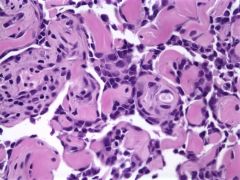
what
|
angiosarcoma
|
|
|
interesting gross appearance of fibrous dysplasia
|
replacement of marrow by fibrosis
|
|
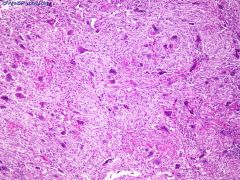
what
|
metaphyseal fibrous defect, usually metaphyseal, adolescence (not too far from growth plate and thought to be error in that), if big some call nonossifying fibroma
|
|
|
most common sites for chondrosarcoma
|
pelvis and shoulder, metaphysis/diaphysis of long bones
|
|
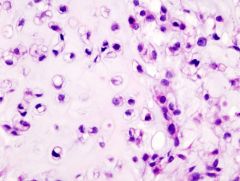
what
|
chondrosarcoma, often lobulated
|
|
|
which is a better prognosis conventional osteosarcomas or periosteal osteosarcomas
|
periosteal osteosarcomas (usu intermediate grade) vs. high grade of osteosarcomas
|
|
|
what is a paraosteal osteosarcoma
|
low grade, surface fibroblastic sarcoma that produces bone/osteoid, arises from the outer layer of the periosteum and therefore does not elevate the periosteum
|
|
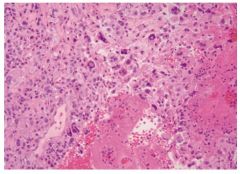
what
|
telangiectatic osteosarcoma
|
|

what
|
osteogenesis imperfecta - blue sclera
|
|
|
mutations in osteogenesis imperfecta
|
mutations in COL1A1, COL1A2 - AD
type I - good quality collagen, abnl quantity type II - die within year type III - progressively deforming remaining types have subtleties but generally can live with but definitely clinical problems |
|
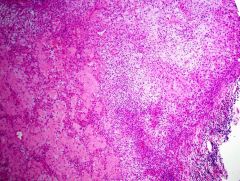
what
|
chondromyxoid fibroma- hypocellular lobules with myxod chondroid appearance with band of highly cellular tissue with fibroblast like spindle cells and osteoclasts
|
|
|
ihc for chondromyxoid fibroma
|
S100
|
|
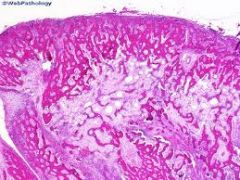
what
|
classic appearance of myositis ossificans; often (but absolutely not always) involves muscle, not inflammatory; zonal phenomenon (central cellular area, intermed zone of osteoid formation and peripheral of highly organized bone
|
|
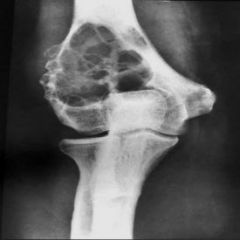
what
|
desmoplastic fibroma, rare: medullary; soap bubble
interlacing bundles of dense collagen and low cellularity on histo |
|
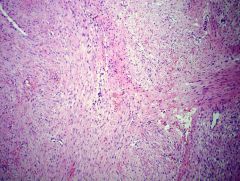
what
|
desmoplastic fibroma
|
|
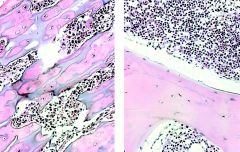
what
|
osteopetrosis
|
|
|
mutation in achondroplasia
|
constitutively active FGFR3, autosomal dominant or sporadic
|

